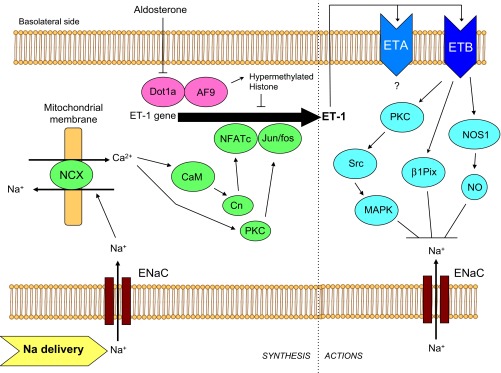Fig. 2.

Model of ET-1 synthesis and actions in the cortical collecting duct. Increased tubule fluid Na+ delivery increases intracellular Na+ concentration via the epithelial Na+ channel (ENaC), leading to mitochondrial Na+/Ca2+ exchange (NCX), activating calmodulin (CaM), calcineurin (Cn), and protein kinase C (PKC), which lead to transactivation of the ET-1 promoter via Ca2+-dependent nuclear factor of activated T cells (NFATc) and Jun/fos. ET-1 is secreted primarily basolaterally where it can activate ETA and ETB receptors in an autocrine manner. Activation of ETB leads to increased protein kinse C (PKC) activity, increased Src tyrosine kinase, and increased mitogen-activated protein kinase (MAPK) activities, which inhibits epithelial Na+ channel (ENaC). ETB also activates β1Pix, which ultimately causes endocytosis of ENaC. In addition, ETB stimulates nitric oxide synthase 1 (NOS1), increasing NO which inhibits ENaC activity. ETA may also inhibit CD Na+ transport, but the signaling mechanisms are unknown. Finally, aldosterone can stimulate ET-1 production by repressing disrupter of telomeric silencing alternative splice variant (Dot1a), reducing interaction with AF9, and derepressing ET-1 gene transcription. Please note that the model is drawn from studies using disparate cell types under different experimental conditions, hence this should be viewed as a conceptual overview.
